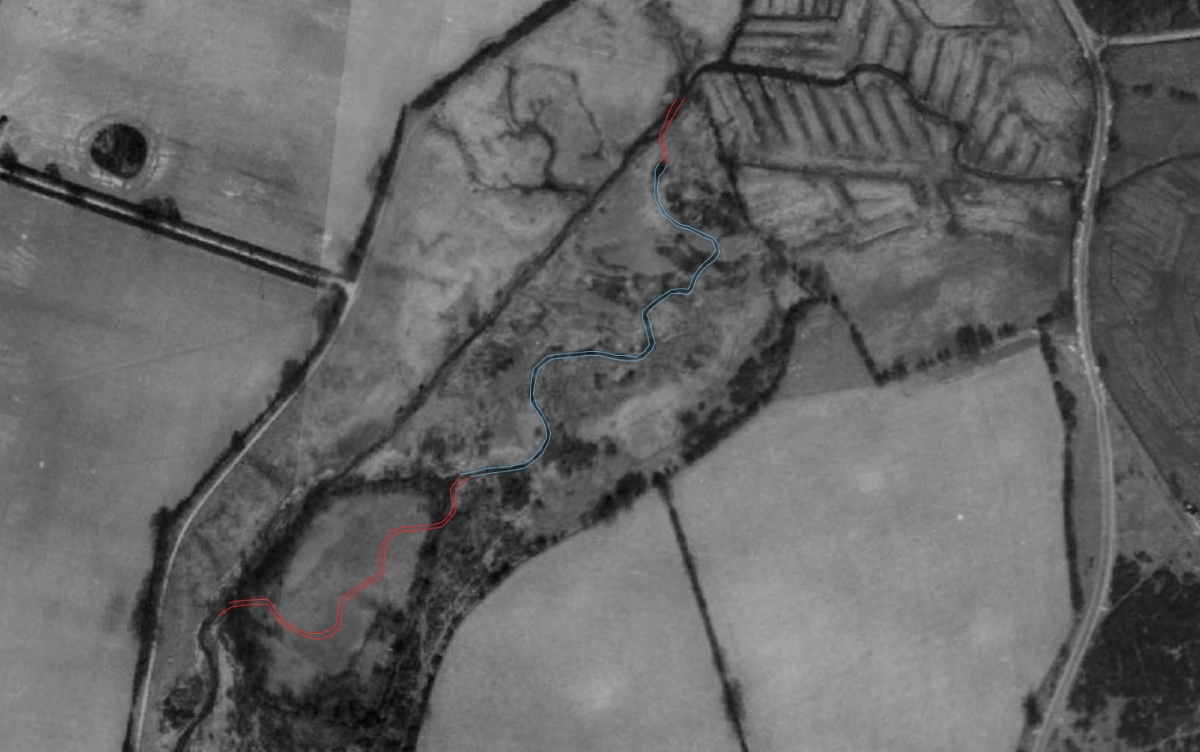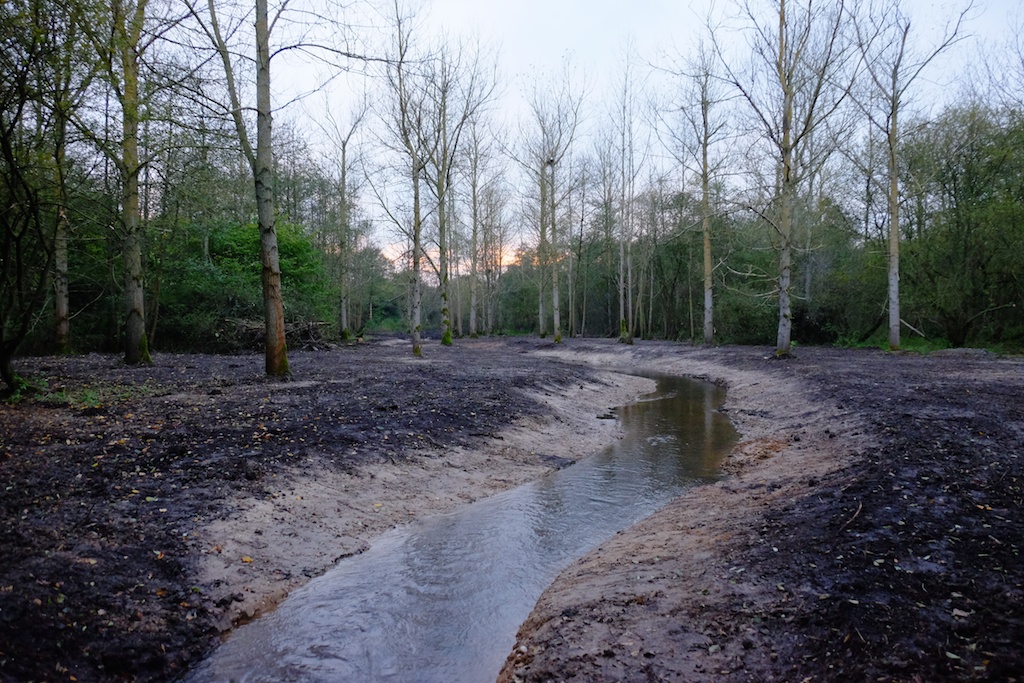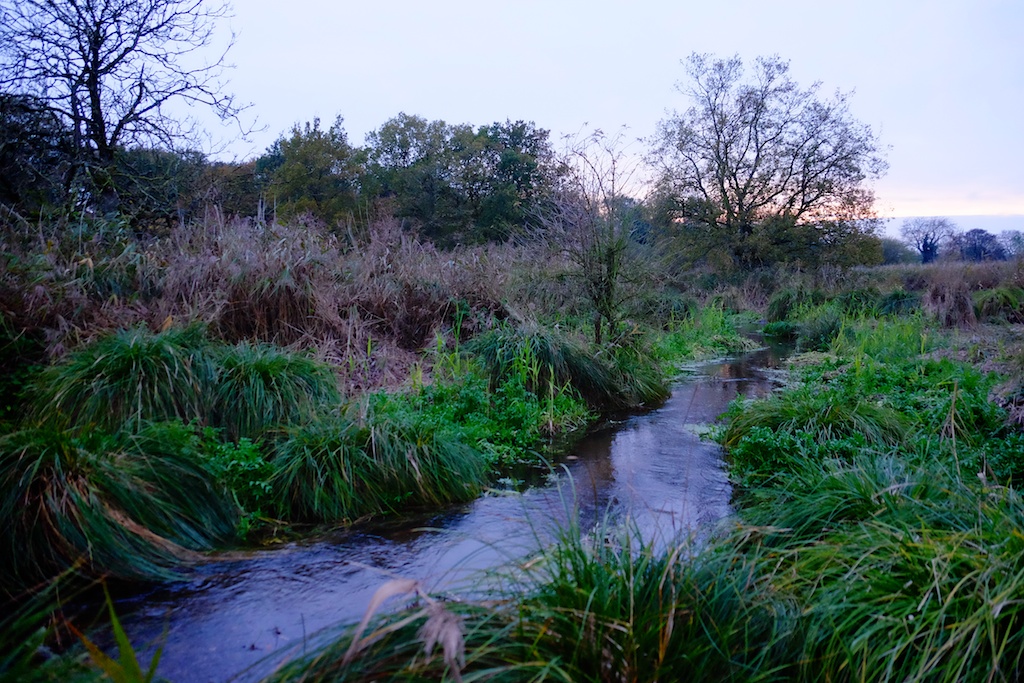The first in a series of blogs for river restorationists. The reason why nothing has appeared on here for the past four months: I’ve been a bit busy helping the Norfolk Rivers Trust deliver a handful of river restoration projects on the River Nar. This one at a site near Castle Acre will start the series because today is the birthday, or rather the re-incarnation day of a lost river. The aerial photo (1946) below shows a part of the River Nar which was changed from its natural course hundreds of years ago when the mill-leat for the downstream mill was cut: the straight channel flowing down the west (left) side of the image. Look east a few yards however and you’ll see evidence in the ground of the abandoned river. In fact it was left there, unfilled and unchanged from the day it was cut off by the leat until today, the 11th of November 2014.
This relic channel is a true rarity on English chalk-streams. More or less every yard of every river has been modified for one reason or another. To find five hundred yards left more or less as the Ice-Age made them was the rivery equivalent of finding the tomb of Tutankhamun. The relic channel was cut off at its upper end and at the lower end was joined to the mill-leat by another straight, man-made channel. This project then was about re-instating the old channel by creating a short linking channel upstream and a longer more natural one re-connecting back to the meandering part of the main river downstream.
The lower channel accounted for 80% of the project time. The available route passed through a slightly raised part of the flood-plain and in the middle reaches it was a challenge to peel away enough ground to make the correct, naturally shallow cross-section. There was little fall to play with too and the main river to which the new channel returned has been dredged (a future project will be sorting that out) and so tuning the gradient proved very tricky. It was worth the effort though. When the flows finally broke through the new channel worked perfectly, with good velocity and no unintentional impoundments.
Restoring the relic channel was as close to actual river restoration as is possible: like peeling varnish off an old painting. A delicate job if the painting is not to be damaged. In practice we went so lightly that it was quite easy. Helen Mandley supervised with an eagle eye and Wayne on the digger performed with great sensitivity. See the photos below for the fuller picture. Amazingly there was very little sediment in the relic channel. Within an hour the flows had scoured their way to the gravel.
Some will know that Nigel Holmes sadly passed away a few weeks ago: it may well have been Nigel who first identified this as potential restoration project in a report (which he co-authored) commissioned by English Nature about ten years ago. This project has been a team effort over the years and Nigel’s early involvement is a reminder of that. I’m sure he would have been chuffed to see it come to fruition. The delivery team included WWF and Coca Cola as sponsors, the Norfolk Rivers Trust as planners and supervisors (Helen Mandley ran the project, and I was there to help fret about gradients, planforms and cross-sections), the Norfolk Rivers Drainage Board (machinery and delivery – thanks to Adrian, Wayne and Graham), Richard Hey, Holkham Estate, The Castle Acre Fishing Club, Natural England and others.












Reblogged this on The River Management Blog and commented:
Charles Rangley-Wilson describes a fantastic project in Norfolk to re-occupy an old chalk stream channel of the Nar.
LikeLike
Charles, great post. Nice to see a genuine example of river “restoration” in practice! It’s a much over-used phrase for generally improving degraded rivers, but in this case the project team look to have actually turned the clock back. Look forward to reading about the rest of the projects!
I hope you don’t mind but I have “reblogged”/linked this from the river management blog.
LikeLike
Hi Simon,
many thanks. I don’t mind the re-blog at all. It’s all about sharing knowledge … or lessons learned!
And yes, I agree ‘restoration’ is often used when instead the project is more of a form of habitat enhancement. ‘Restoration’ implies a specific idea of what is being restored. But our rivers have been so heavily modified over the centuries, so what state are we restoring? My take is that there are basic physical characteristics in un-modified ‘natural’ rivers (which is why this relic channel is so interesting), in planform, cross-section, homogeneity etc. and that restoration is about trying to restore those characteristics whilst also making room for the layered history of the river.
Best, Charles.
LikeLike
What a fascinating project to be involved in. I wonder are there may more relict streams out there waiting to be found.
John
LikeLike
Hi John,
I’m sure there are. In Norfolk there’s a great historic maps website which allows you to look back over 1946 aerial photos, 19thC OS maps and in places tithe maps. You can use these and satellite images to find old river courses. But this one we restored stood out because the channel was so pristine and hidden away on a piece of land that hadn’t changed or been used much in all that time.
But I’m sure there would be sites like this on the limestone streams of Ireland.
best,
Charles.
LikeLike
Dear Charles,
Truly wonderful work and good to see a natural looking chalk stream. Will this stream ever be fished? The riverbank looks to be of a delicate nature. Perhaps there could be a totally new approach to fly fishing these small streams by standing two to three metres back from the waters edge (good practice anyway) before taking a cast. Although done in a sensitive manner I always found rivers like the Itchen too manicured and controlled.
Keep up with the good work this really is a positive piece of ecology which makes for a refreshing change.
Best
Nick
LikeLike
Thanks Nick. The river is fished lightly … and has never been stocked!
LikeLike
Have you blocked off the old (newer straightened) channel?
LikeLike
At the upper end the peat and turf that came out of the diversion have been placed behind some LWD in the old leat channel to help divert the main-flow: but this only forms a short berm. Downstream of this point there will still be flow in the old leat because it picks up several springs. It will become a gently seeping, linear pond of sorts. Personally I feel that retaining these previous incarnations in one form or other is desirable, especially if they can become habitat features in their own right.
LikeLike
I am open-mouthed with admiration; I used to walk in this tiny corner of dreams amongst the agridesert a quarter-century ago, and had always wondered how the stream had been subsumed by that crazy swamp.
A fascinating account. I shall return again this summer to view your remarkable efforts & raise a pint to you in The Ostrich.
LikeLike
Hi Jon,
thanks for that. I really appreciate it. It’ll look a lot better in the summer too. The scars and stitching are still visible at the mo.
Charles.
LikeLike